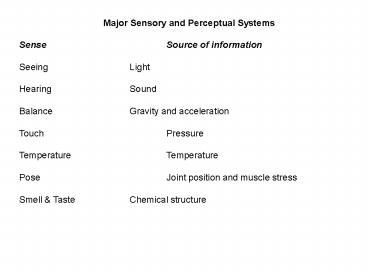Major Sensory and Perceptual Systems PowerPoint PPT Presentation
1 / 26
Title: Major Sensory and Perceptual Systems
1
Major Sensory and Perceptual Systems Sense Sou
rce of information Seeing Light Hearing Soun
d Balance Gravity and acceleration Touch Pr
essure Temperature Temperature Pose Joint
position and muscle stress Smell
Taste Chemical structure
2
Overarching Principle Sensory and perceptual
systems (including their associated mechanisms
for learning and plasticity) evolve in the
service of obtaining information about the
environment that is relevant for the tasks the
organism must perform in order to survive and
reproduce. Corollary The design of the
sensory and perceptual systems is determined by
the tasks it performs, by the physical/statistical
properties of the environment, and by various
biological factors/constraints.
3
Sensory and Perceptual Processing Starts with
Transduction
Transduction the transformation of physical
energy into a neural code (changes in membrane
potential, generation of action
potentials) Transduction is the responsibility
of specialized neurons called receptors A
receptor is specialized to respond best to one
particular type of stimulus energy
4
There Are 4 Basic Types of Receptor Cells
Mechanoreceptive Somatosensory (touch)
Proprioceptive (muscle and joint receptors)
Vestibular Auditory (Lateral line) Chemical
Olfaction Taste Thermal Temperature
Electromagnetic Vision (Electroreception)
(Infrared detection)
Pain receptors may fall into any of the first
three categories
5
Stimulus energy
TRANSDUCTION
Receptor potential
mV
Time
Action potentials
mV
Time
Stimulus triggers a receptor potential in the
receptor receptor potential triggers action
potentials in the transmission neuron (or its own
axon if it has one) the CNS only sees the action
potentials
6
Receptors can have axons which transmit signals
to the central nervous system (e.g.,
somatosensory, olfaction), or they can make a
synapse on a second, separate transmission
neuron, which relays the signal to the central
nervous system (e.g., audition, vision)
Receptor portion
Touch Receptor (Dorsal Root Ganglion Cell)
Transmission portion
Auditory Receptor (Hair Cell)
Transmission Neuron (Spiral Ganglion Cell)
To Brain
To Spinal Cord
7
(No Transcript)
8
(No Transcript)
9
(No Transcript)
10
(No Transcript)
11
(No Transcript)
12
Comparison patch
13
Difficult Problems for Perceptual
Systems Context problem Objects often appear in
a complex and varying context of other objects,
making recognition of objects difficult. Category
complexity problem The specific things that
define a category are often quite different,
making categorization difficult. Missing
dimensions problem Vision The images in the
eyes have two-dimensions in space and one
dimension in time. The third dimension in space
(depth) is lost and must be reconstructed.
Audition, Olfaction The signals reaching the
ears and nose have one dimension in time. Any
other dimensions must be reconstructed.
14
Approaches to Understanding Sensory
Systems Natural tasks Natural scene
statistics Anatomy Responses of and within
individual neurons Responses of neural
populations Perceptual/behavioral
performance Mathematical and computational
modeling
15
(No Transcript)
16
Approaches to Understanding Sensory
Systems Natural tasks Natural scene
statistics Anatomy Responses of and within
individual neurons Responses of neural
populations Perceptual/behavioral
performance Mathematical and computational
modeling
17
Natural reflectance spectra
Regan et al. (2001)
18
(No Transcript)
19
Approaches to Understanding Sensory
Systems Natural tasks Natural scene
statistics Anatomy Responses of and within
individual neurons Responses of neural
populations Perceptual/behavioral
performance Mathematical and computational
modeling
20
Microscopy, Imaging, Assays Single and
multi-unit recording Optical, Calcium,
Functional-MR imaging Event related potentials
(ERPs) Lesion, Knockouts, etc.
21
Behavioral Approaches
C
B
A
description
feedback
objective
identification
no feedback
subjective
estimation
22
2AFC Task
23
(No Transcript)
24
Computational/Mathematical Approaches
Descriptive models Normative (optimal)
models Information processing models Physiologic
al models
25
A Physiological Model of Receptor Responses
Multiply by transmittance
Multiply by absorption spectrum and sum
Convolve with point spread
Sum over each receptor aperture
26
Recurrent Themes
Perception is a very complex process. Perception
generally involves the integration of many
sources of information most of which are not very
reliable. There are many approaches to the study
of perceptual systems and each has made important
contributions to our understanding.

